May 1, 2013
Deep Space Sparkle Blog
I recently came accross the website Deep Space Sparkle,and it has really great, tried, tested and true art projects for kids. It also links to a lot of art-teachign related items.
I found a great robot painting lesson on here for grade 4 students.
http://www.deepspacesparkle.com/2012/05/19/robot-painting-art-lesson/
Apr 3, 2012
Worthwhile Links
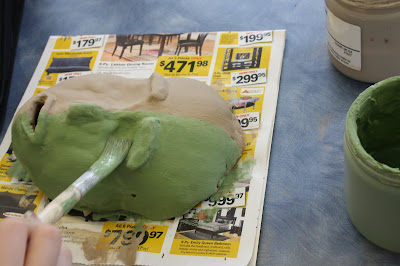
I've been scrolling the internet for ideas, and have come accross a few new sites, and some that I always return to visit.
Here is a list of great resources with postings by other art teachers out there:
1. My number one reccommended site is The Incredible Art Department. It is categorized very well with loads of lesson plans listed in age groups, mediums, artist, and more.
2. A site that has fantastic usable ideas over and over again is Art Projects for Kids, by Kathy Barbro. I have gone back to this site many times for elementary school art projects, and projects that work for my high school students with modified and special needs. I really appreciate how so much of the art for children here is centred around an artist's work, and that is the jumping off point for students.
3. I came across Art-rageous. It is a site with a lot of great ideas for high school art projects. I will definately be using some of them. The main layout could be more user-friendly, but there are really good photo examples of student work.
Apr 2, 2012
Plasticine Trees
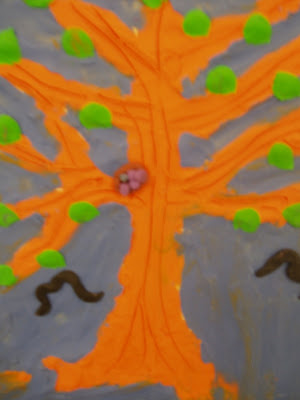
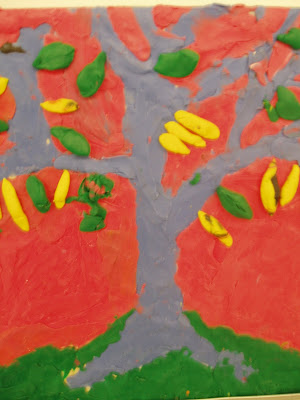
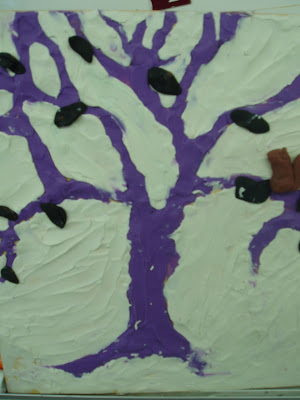

My special needs students created these plasterceine versions of trees. It was a great medium for them to work with that allowed them a different kind of control than painting or colouring. They worked on 1/8 inch plywood or masonite sheets. They did need some help first having a tree sketched out as a starting point, and then filled in their colours with the plasterceine clay. For my students with developmental delays and limited dexterity this was a really good project. Most spent a little over an hour working on it, and a few other students needed more time than that.
This would work well for an elementary art class, or junoir high. It could also be adapted with more requirements or themes for a high school class. There are various illustrators out there who use this medium, which could be worked into a lesson to show real-world connections. Here is a great site for illustrator Barbara Reid who illustrates children's book mainly using the relief plasterceine method, and a sample of her work below:
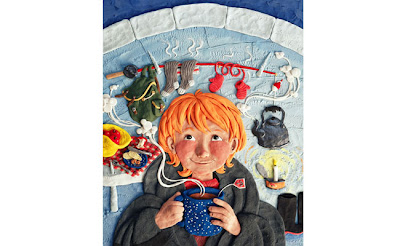
Labels:
barbara Reid,
clay,
elementary,
high school art,
illustration,
jr high,
plasterciene,
relief,
special needs
Mar 22, 2012
Pop Art for Kids


Alright,so I've decided to resuscitate this blog that really barely ever got going. I frequently take a look at other art teacher's blogs, and LOVE it that so many people talk about what they do in an art class, so I thought I'd start blogging more regularly about what I do.
I teach high school art, and one of my biggest challenges is finding the time to plan assignments for the students that have special needs and are on individual education plans. Often these students will work on the same assignment as the rest of the class, but more often they will finish the assignment very quickly and will need other programming. I really love having students with different abilities and I actually really love planning new activities for them. My main problem is finding the time to plan and prep for all the extra activities. I love it when I hit on something that doesn't require a lot of prep, that fills our 115 minute time slot, and that looks good in the end.
Here are some recent creations, as a sort of ode to Andy Warhol. I previously took pictures of each student, photocopied them into sets of 4, and then had the students paint each portrait with a different colour set. They then glued their images down onto larger paper. The mot successful ones are the ones with a different colour background than foreground. This assignment promotes colour mixing, builds hand eye coordination and dexterity, an allows the students to make choices about their paint. Sometimes I find that with watercolour paint or tempera paints they can end up with something that looks more successful than with colouring materials such as pencil crayons. One student had no interest in painting a photo of himself, but he loves school buses so we photocopied a picture of a bus, and suddenly he was very keen on this assignment.
This project would work well for elementary students, possibly a simple quick project for Jr high students, and I could see the idea of it being adapted a little for high school students if more complex colour requirements were added, or if students were given the chance to edit their photos in photoshop beforehand to up the contrast, convert to black and white, and posterize their images.
Sep 22, 2010
School Begins, and Art is being made!
School is now in full swing, and I feel like I'm setting into my new position very nicely. I can barely even begin to describe how nice it is to teach in ONLY ONE classroom, and to not have to pack up and cart the art supplies around. Also to actually have supplies readily available without having to hunt them down or order them is also incredibly lovely (my new art room was very well stocked when I arrived!). I feel like I could write a lot about the school year starting, and most of it would probably be your run-of-the mill school starting stories, but I just felt like remembering this one moment from today:as a student was leaving today He thanked me for today's class. It was really nice because I didn't even feel that today was a particularly amazing teaching day- it was fairly average as far as I am concerned, so it's nice to know that at least one student appreciated me enough to thank me for what I do.
I will be posting some new assignments soon, once there is some finished work to post.
I will be posting some new assignments soon, once there is some finished work to post.
Jul 5, 2010
Summer is here, and my new job awaits!

School has ended!! With the school year ending, the art program that I ran ends as well. It will not be returning next year. The division decided they didn't have the funds for it next year (at least that's how I understand they came to that decision). The art program had only a short run- I started only in February as the division's only full-fledged art teacher, teaching art to Senior High students in three different schools. I loved the job, but really disliked all the travel involved-I wasn't willing to move closer to any of the schools for only a 5 month position, and having already lived in Ashern, Manitoba for a 10 week term I have decided that at this point in my life, rural living is not for me. With that in mind I decided that I would rather drive for long periods every day. My shortest drive was 50 minutes, and my longest about an hour and 40 minutes (but thankfully the longest drive only happened twice a month). As well what I disliked was packing and unpacking the supplies every few days (or even every period) since I shared many classrooms between all the schools. I am sad for the students of Lakeshore, especially those who really love and flourish at art. There are a few students who loved art and really recognized that the pull-out art program was unique from the rest of their education, because they would occasionally thank me at the end of the day for coming (I love those moments!).
For me at least, I am moving on to greener pastures. I am starting at a new school in the fall, and am very excited to actually have my own art room! Also my new school is about an hour closer to home. I visited the school and met with the art teacher who just retired and am so stoked to actually teach an already established art program in a room that is actually well stocked! I could go on and on just about the room itself and the things that make me happy about it, but I will list just a few items that make me excited for teaching in the fall:
A Kiln!
A potters wheel!
Exacto knives!
Silk Screen Machine! (Which I need to learn how to use...)
Wall to Wall windows!
Books and resources!
For my summer reading and planning I took home a huge stack of binders and books to help me plan out the courses, one of which is pictured above. Titled "Engaging the Adolescent Mind Through Visual Problem Solving," it was written by Ken Vieth. I have only just flipped through it, but it appeals to me because it has great colour photos, and I feel like it's been a while since I've actually been excited to read a book about education(sorry to say, but most of the assigned readings during my education degree didn't hold that much interest for me.)
Here is an amazon link to it:
http://www.amazon.ca/Engaging-Adolescent-Mind-Ken-Vieth/dp/0871926946
I'll have to let you know my opinion of it once I finally get the chance to read it more thoroughly.
Jun 30, 2010
Watercolour Assignment:
Illustrate a Song, Poem or Story
You will be choosing a song, poem, story or legend to illustrate. You do not have to make up the text, but if you choose you can create a story to illustrate.
You will be making a watercolour painting to illustrate your story, song or poem. You may decide to illustratate only one line from the song, poem or story, or you may decide to include a lot of imagery from the song, poem or story.
Think about the colour scheme!(what colours will give different emotions related to the song? )
1. Start by finding a story, poem or song.
2. Create sketches for what your images will look like and the layout of the page.
3. Lightly sketch the image on watercolour paper.
4. Paint the images carefully on the watercolour paper.
5. As the final step Include the text either on the page itself, by drawing it on, or print it on the computer to glue on, or Print as a separate page to be shown with the work. (If your writing is not neat, choose to print your text on the computer).
**REMEMBER TO CREATE YOUR OWN IMAGES; DO NOT USE IMAGES THAT SOMEONE ELSE HAS ALREADY CREATED!
FOR EXAMPLE, DO NOT DEPICT WINNIE THE POOH BECAUSE THAT IS A DISTINCT CHARACTER THAT SOMEONE ELSE MADE.
Watercolour Song Illustration Evaluation
Use of Images: Images enhance and illustrate the text well. Images show evidence of planning and thought to the final design (Hand in sketches). Images are interesting to look at, and are original designs. There are a variety of viewpoints or angles, or different types of scenes. Creativity and strong composition are demonstrated. 21 (7 per page)
Use of Medium and color choices: Watercolours were used with accuracy, skill, blending of colours, variety of shades and tints. Background painted first, then the foreground. 12 (4 marks per page)
Quality of Workmanship: Neat, clean, accurate, using care and attention on piece. 9 (3 per page)
Text is included or attached to images in a way that is appealing to the design and images. 3 (1 per page)
Total: /45
Illustrate a Song, Poem or Story
You will be choosing a song, poem, story or legend to illustrate. You do not have to make up the text, but if you choose you can create a story to illustrate.
You will be making a watercolour painting to illustrate your story, song or poem. You may decide to illustratate only one line from the song, poem or story, or you may decide to include a lot of imagery from the song, poem or story.
Think about the colour scheme!(what colours will give different emotions related to the song? )
1. Start by finding a story, poem or song.
2. Create sketches for what your images will look like and the layout of the page.
3. Lightly sketch the image on watercolour paper.
4. Paint the images carefully on the watercolour paper.
5. As the final step Include the text either on the page itself, by drawing it on, or print it on the computer to glue on, or Print as a separate page to be shown with the work. (If your writing is not neat, choose to print your text on the computer).
**REMEMBER TO CREATE YOUR OWN IMAGES; DO NOT USE IMAGES THAT SOMEONE ELSE HAS ALREADY CREATED!
FOR EXAMPLE, DO NOT DEPICT WINNIE THE POOH BECAUSE THAT IS A DISTINCT CHARACTER THAT SOMEONE ELSE MADE.
Watercolour Song Illustration Evaluation
Use of Images: Images enhance and illustrate the text well. Images show evidence of planning and thought to the final design (Hand in sketches). Images are interesting to look at, and are original designs. There are a variety of viewpoints or angles, or different types of scenes. Creativity and strong composition are demonstrated. 21 (7 per page)
Use of Medium and color choices: Watercolours were used with accuracy, skill, blending of colours, variety of shades and tints. Background painted first, then the foreground. 12 (4 marks per page)
Quality of Workmanship: Neat, clean, accurate, using care and attention on piece. 9 (3 per page)
Text is included or attached to images in a way that is appealing to the design and images. 3 (1 per page)
Total: /45
Artist Research Project
Here is an artist research assignment I had my students do. (On the worksheet I had included pictures of the artists self portraits, but I couldn't cut and paste it...) It can be left as a worksheet, or I have also used these same questions as a guide for students to use for a powerpoint project. With the powerpoint research project, they had to put the answer to each question on a slide.
Self Portrait Artist Research
Working by yourself, choose one self portrait artist from the following list and answer each question about the artist on the following page.
Choose from the following artists:
Chuck Close Rembrandt Vincent Van Gogh Francis Bacon
Frida Kahlo PabloPicasso Andy Warhol Albrecht Durer
Max Beckman Yasumasa Morimura Lukas Samaras
Do a google search in google images for the artist to get an idea of what their art typically looked like.
You can use one of these sites as references, or use other sources:
www.Encyclopedia.com
www.wikipedia.com
For quotes try using
http://www.brainyquote.com/quotes/topics/topic_art.html
http://artquotes.net/
Answer in Complete Sentences and In your own words
1. Where is this artist from originally, and where did they live for most of their life?
2. What kind of work is this artist known for making? What style of art do they make, and what art movement are/were they a part of?
3. Describe how they portray themselves in their selfportaits in your own words- (What kind of images do they use? Are they realistic? Are they highly stylized? What kinds of colours do they use? Are they paintings, drawings, or photos? Are they serious or is it lighthearted or funny?)
4. What has the artist said about the art they create?(find a quote by the artist about art).
5. Describe something about your artist’s life (Examples include: were they married, were they friends with other artists, did anything significant happen to them throughout their lives such as an accident, or were they recognized in any significant way for their art?
6. What is something that you found surprising about this artist?
7. List your references or where you found your information.
*With this rubric, students were expected to create at least 8 slides.
Powerpoint Artist Research Project Evaluation
Use of Information: Point form. Appropriate amount of information. Used own words. Answered each question appropriately( 2 marks per slide). Slides show a general knowledge of the artist. Sources cited.
/2 /2 /2 /2 /2 /2 /2 /2
Use of pictures: Used at least 5 pictures throughout or more.
1 2 3 4 5
Layout and General Presentation-Images and text are displayed in a way that is appealing and makes sense. Powerpoint features were used to enhance information and images. Logical flow to each slide. Consistent layout, fonts, texts, etc.
1 2 3 4 5 6 7 8
Total: /28
Self Portrait Artist Research
Working by yourself, choose one self portrait artist from the following list and answer each question about the artist on the following page.
Choose from the following artists:
Chuck Close Rembrandt Vincent Van Gogh Francis Bacon
Frida Kahlo PabloPicasso Andy Warhol Albrecht Durer
Max Beckman Yasumasa Morimura Lukas Samaras
Do a google search in google images for the artist to get an idea of what their art typically looked like.
You can use one of these sites as references, or use other sources:
www.Encyclopedia.com
www.wikipedia.com
For quotes try using
http://www.brainyquote.com/quotes/topics/topic_art.html
http://artquotes.net/
Answer in Complete Sentences and In your own words
1. Where is this artist from originally, and where did they live for most of their life?
2. What kind of work is this artist known for making? What style of art do they make, and what art movement are/were they a part of?
3. Describe how they portray themselves in their selfportaits in your own words- (What kind of images do they use? Are they realistic? Are they highly stylized? What kinds of colours do they use? Are they paintings, drawings, or photos? Are they serious or is it lighthearted or funny?)
4. What has the artist said about the art they create?(find a quote by the artist about art).
5. Describe something about your artist’s life (Examples include: were they married, were they friends with other artists, did anything significant happen to them throughout their lives such as an accident, or were they recognized in any significant way for their art?
6. What is something that you found surprising about this artist?
7. List your references or where you found your information.
*With this rubric, students were expected to create at least 8 slides.
Powerpoint Artist Research Project Evaluation
Use of Information: Point form. Appropriate amount of information. Used own words. Answered each question appropriately( 2 marks per slide). Slides show a general knowledge of the artist. Sources cited.
/2 /2 /2 /2 /2 /2 /2 /2
Use of pictures: Used at least 5 pictures throughout or more.
1 2 3 4 5
Layout and General Presentation-Images and text are displayed in a way that is appealing and makes sense. Powerpoint features were used to enhance information and images. Logical flow to each slide. Consistent layout, fonts, texts, etc.
1 2 3 4 5 6 7 8
Total: /28
Labels:
Art assignments,
powerpoint,
research assignments
Jun 14, 2010
Figure Sculpture Project


An assignment I have done with several classes this year is a figure sculpture assignment. Students create a miniature figure using tinfoil, plaster bandages, plaster, and paint. Some have turned out really well. For many students it is an enjoyable project because they get to use different materials, and each step along the way is a little bit different, so every class brings something new, there isn't time to get bored with it(for most of them...).
Starting with a lesson on doing some figure sketching, I then lead into the project. Depending on the time I have with each class I may spend more time drawing the figure and focusing on that before starting on the sculpture assignment.
Supplies needed:
tinfoil
plaster bandages
plaster of paris
paint
primer
Pieces of wood to use as a base
nails or screws
sandpaper
1. To begin students are to decide on a emotion, or theme that they want to express with the body language of their figure. They then do a few sketches to get their ideas down and so that there is a goal in mind.
2. They start with a piece of tinfoil about 1 foot or a foot and a half long. I found that thicker tinfoil works best, and you won't need as much for the whole class. Make several slits in the tinfoil as a basic template as to where the arms and legs, and head goes. Smush, crumple, and shape the tinfoil into the shape of a person. Be careful about proportions, thickness and height.
3. Attach tinfoil character onto a nail on the wooden base. You may need more that one nail to keep it steady and free from wobbling. Sometimes I will have students attach the tinfoil to the screw threw the calf, and then add another nail where the foot will go so that you can build up the foot around the nail.
4. Cut plaster bandages into strips up to an inch wide, and about 5 inches long. Dip in water and cover tinfoil with bandages. You will probably need at least 2 layers of bandages. Make sure that where the weight of the sculpture is there is enough layers of bandages so that it cannot bend or break.
5. Use plaster of Paris to fill in any gaps, or to smooth out areas. Let dry.
6. Take Sandpaper and sand down any areas.
7. Prime sculpture with acrylic primer. If you don't prime it the paint will end up flaking off of the bandages.
8. Paint sculpture with acrylic paint.
Sometimes I need to add some glue to keep the sculpture from wobbling or moving around. Glue gun glue works well for this. I have also done this project using chicken wire instead of tinfoil, but found that it was too hard to shape. Tinfoil allows for more details. If you went larger then chicken wire might be needed.
Figure Sculpture Evaluation
Use of materials: The figure was built up well. The student makes good use of the materials. The student followed directions on creating a sculpture base, using plaster bandages, plaster and paint. The student demonstrated skill in the use of these materials. Figure structure is sturdy. Student has learned the basics of sculptural design.
1 2 3 4 5 6 7
Proportions, Figure stance, Theme and Creativity The figure shows emotion or the theme it was intended to express. The figure is proportionally accurate, or the proportions of the figure add to the significance of the theme. Sculpture demonstrates creativity.
1 2 3 4 5 6 7 8
Final Product, Process and Workmanship: The final result of the figure is interesting to look at. The colours and the paint enhance the sculpture. The student has demonstrated neatness and accuracy. The student has demonstrated consideration for all aspects of this piece. The student has shown skill in creating a 3-dimensional sculptural piece.
1 2 3 4 5 6 7 8 9 10
Total: 25
Jun 1, 2010
Human Rights Painting Project


I sent an email out to a teacher who was on the lookout for teachers who promote social justice or human rights issues within their school or classroom. I thought I'd share about this painting project that I had my grade 9 art class do. Students were to take a human rights issue and promote, uphold, or show an original perspective on that issue through a painting. They were to think about what kinds of symbols and imagery they could use to represent issues based around the Declaration of Human rights put out by the United nations. I suggested they start with a quote by a famous human rights advocate, and try to come up with some relatable images. This was a challenge for most of my students, and in retrospect this may be a project better suited for a grade 11 or 12 class, but there were several students who really took the project to heart and ended up with some really nice paintings. The pictures shown above are student examples. I decided to do this project because of a Canada-wise painting contest that was open to high school students.
I started the assignment by showing students video about the Declaration of Human rights. This was useful not only to inform students, but also to get them thinking about possible symbols and images(and that their images did not need to be elaborate to show the idea). I also supplied a handout of quotes by Human Rights Leaders to get students started.
Here are some video links that I showed in class:
Declaration of Human rights:
http://www.youtube.com/watch?v=hTlrSYbCbHE&feature=PlayList&p=D24E69D89D157FFF&playnext_from=PL&index=1
http://www.youtube.com/watch?v=xYQ-rvvF48U&feature=PlayList&p=D24E69D89D157FFF&playnext_from=PL&index=2
Martin Luther King Jr. Video:
http://www.youtube.com/watch?v=qV9plu2jLy4&feature=PlayList&p=D24E69D89D157FFF&playnext_from=PL&index=0
Here is the handout that I gave students:
Human Rights Perspective
Painting Assignment
You will be creating an image that promotes, upholds, encourages, or shows perspective on a human rights issue.
Human Rights Definition:
pl.n. The basic rights and freedoms to which all humans are entitled, often held to include the right to life and liberty, freedom of thought and expression, and equality before the law.
You will be creating your image with acrylic paint on illustration board. You can reflect on the past, present, or even think of potential issues for the future.
To begin this assignment:
1. Brainstorm about what kind of human rights issue is important to you.
1. Complete an Internet search for a quote regarding a human rights issue. http://www.wisdomquotes.com/cat_human_rights.html
Use a quote as a basis for your ideas. OR if you have a good idea to start with of what images you want to use then start sketching.
2. Begin some sketches about what kinds of images and words you will use. You may choose to illustrate the quote, and include the words, or work only with images.
3. Sketch your image on illustration board.
4. Paint your image.
5. Write a paragraph reflecting on what images you chose to use and why, and your opinion of your finished piece.
Some Human Rights activists who may inspire you with their quotes: Nelson Mandela, Martin Luther King Jr, Mother Theresa, Ghandi, Jimmy Carter….there are many more…
Human Rights Painting Evaluation
Workmanship-Neat and clean. Time, effort, process and planning are demonstrated
/4
Creativity and Composition- Images used are creative and original. They are arranged in an interesting way that makes good use of the space. /10
Use of theme-Human Rights issues are evident in the painting. Images and words promotes, upholds, encourages, or shows perspective on a human rights issue successfully.
/6
Use of Paint and colour choice-Paint is blended well and is evenly applied. Colours used enhances the piece. Colours are mixed well. There is a variety of darks and lights. Colours have been blended to create a variety of colours. More than one layer of paint is applied where needed.
/10
Total: /30
Labels:
acrylic,
grade 9,
human rights,
painting assignments,
Projects
Subscribe to:
Posts (Atom)
